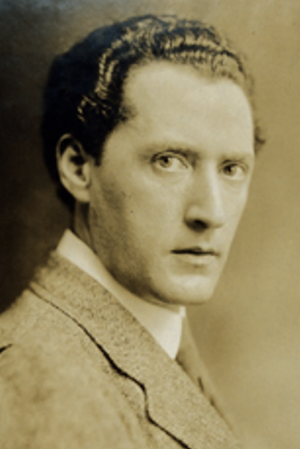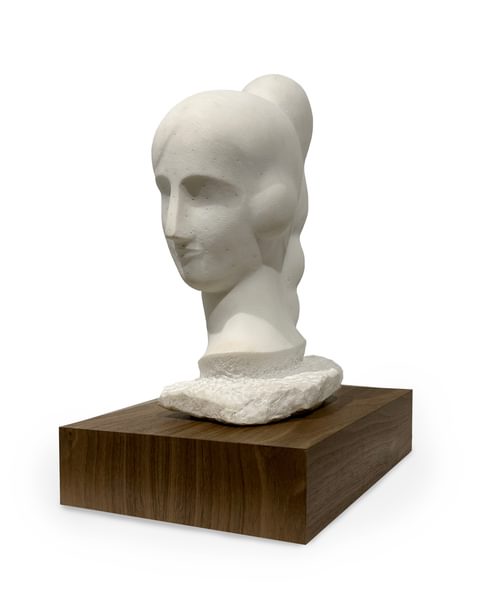Elie Nadelman
Eliasz “Elie” Nadelman was a Polish/American sculptor who became interested in classical antiquities after visiting the Glyptothek in Munich at the age of 20. He lived in Paris from 1904 to 1914 and was closely involved with the avant-garde, exhibiting at the Société des Artistes Indépendants and at the Salon d'Automne from 1905 to 1908. He is regarded as a highly important figure in early 20th-century modern sculpture, but his early cubist drawings were of such note that Picasso visited his studio in 1908 to see them. His first solo exhibition in 1909 was at the Galerie Druet in Paris, comprising a large series of plaster and bronze classical female heads and full-length standing nudes. Gertrude Stein did not usually enjoy sculpture very much, but made an exception for Nadelman whom she supported very early on. He was well introduced and mixed with the Parisian avant-garde circles gravitating around the Steins. It seems that he was less admired by Matisse, whose jealous resentment went so far as to put up a sign reading ‘No talking about Nadelman here’ at the entrance to his studio.
He moved to the United States during the outbreak of World War I, eventually becoming an American citizen in 1927. He and his wife assembled a large collection of folk art and founded a Museum of Folk Arts in Riverdale, N.Y. in 1925. His own style was combined the Classical with a new kind of urban folk art. He held his last one-man exhibition in 1930 at Bernheim-Jeune in Paris.
The Nadelman’s wealth vanished in the Depression and his work fell for a time to the periphery of Modernism. He did not take any commissions other than portraits. In 1937 the collection of the Museum of Folk Arts was sold to the New York Historical Society. In 1935 many of his plaster figures and wood carvings were destroyed by workmen sent to remodel his studio. This event profoundly saddened Nadelman who then packed away all his pre-1935 work in the attic and cellar of his home in Riverdale and left it there. After his death in 1946, his sculpture "Man in the Open Air", was restored and reintroduced in a retrospective at MOMA, New York. His reputation has since grown considerably and his work is in the permanent collections of MoMA, the Met and the Jewish Museums in New York as well as Wadsworth Atheneum and many others.
Featured Artists
- Albers Anni
- Ancart Harold
- Andre Carl
- Avery Milton
- Baldessari John
- Barnes Ernie
- Calder Alexander
- Castellani Enrico
- Clough Prunella
- Crawford Brett
- Dadamaino
- de Tollenaere Saskia
- Dyson Julian
- Elsner Slawomir
- Freud Lucian
- Gadsby Eric
- Gander Ryan
- Guston Philip
- Haring Keith
- Hartung Hans
- Hayes David
- Held Al
- Hepworth Barbara
- Hill Anthony
- Hitchens Ivon
- Hockney David
- Hutchinson Norman Douglas
- Jenney Neil
- Katz Alex
- Kentridge William
- Knifer Julije
- Kusama Yayoi
- Le Parc Julio
- Leciejewski Edgar
- Léger Fernand
- Levine Chris
- Marchéllo
- Martin Kenneth
- Mavignier Almir da Silva
- Miller Harland
- Mitchell Joan
- Modé João
- Moore Henry
- Morellet François
- Nadelman Elie
- Nara Yoshitomo
- Nesbitt Lowell Blair
- Nicholson Ben
- O'Donoghue Hughie
- Pasmore Victor
- Perry Grayson
- Picasso Pablo
- Pickstone Sarah
- Prehistoric Objects
- Riley Bridget
- Ruscha Ed
- Sedgley Peter
- Serra Richard
- Shrigley David
- Smith Anj
- Smith Richard
- Soto Jesús Rafael
- Soulages Pierre
- Spencer Stanley
- Taller Popular de Serigrafía
- The Connor Brothers
- Vasarely Victor
- Vaughan Keith
- Whiteread Rachel
- Wood Jonas

